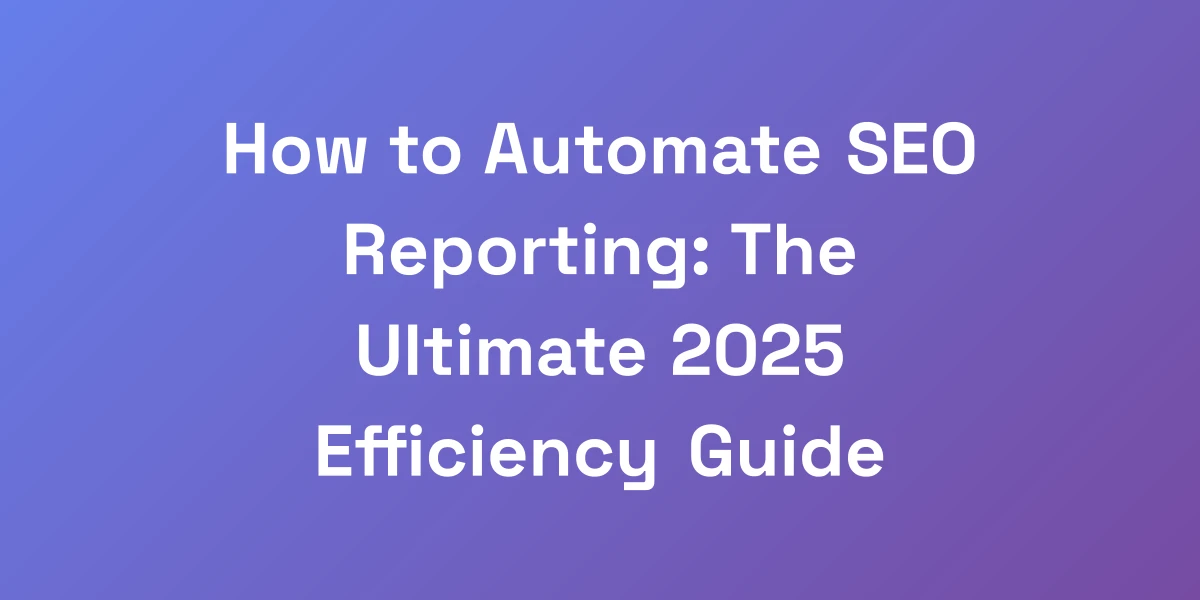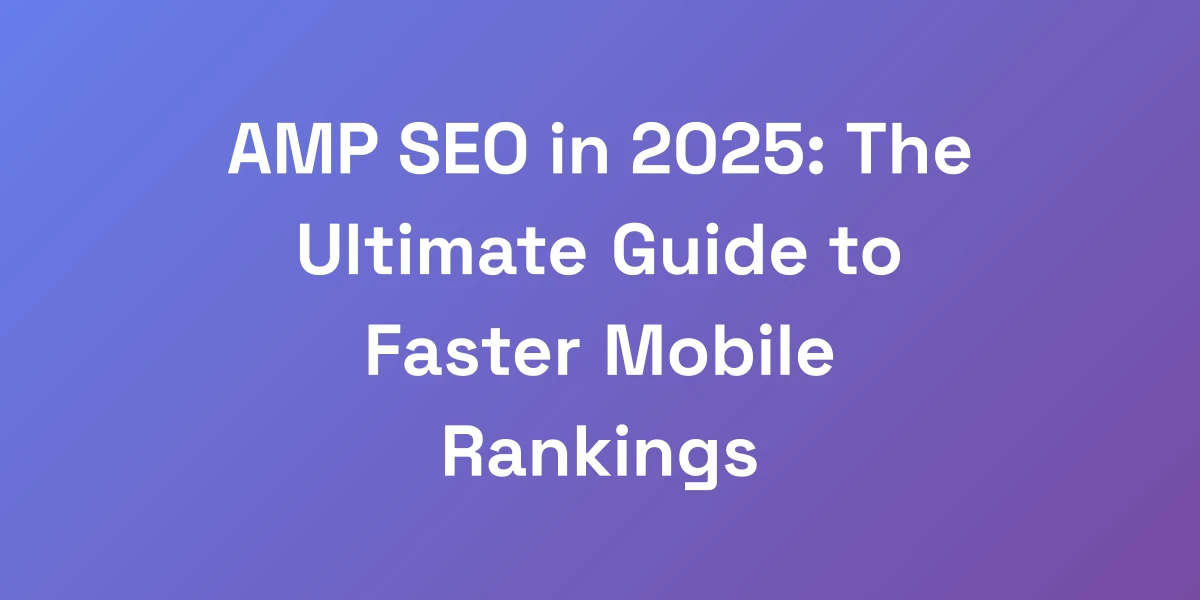
How to Automate SEO Reporting: The Ultimate 2025 Efficiency Guide
Feb 24, 2025 | By [email protected]
Introduction
Ever felt like SEO reporting is draining your time and energy, leaving you with little room for creativity and strategy?
We’ve all been there. Crafting detailed SEO reports manually can be a tedious process, often taking hours that could be better spent on optimizing content or brainstorming new strategies.
But what if there was a way to automate SEO reporting, saving you over 10 hours a week? Imagine having your reports generated effortlessly, with accurate data and insightful analytics, all while you focus on what truly matters – growing your online presence.
In this guide, we’ll explore how automating your SEO reporting can revolutionize your workflow. We’ll tackle the common challenges, highlight the best tools, and provide a step-by-step process to set up your own automated system. Whether you’re a seasoned SEO expert or just starting out, this guide is designed to help you streamline your reporting process and boost your productivity.
Ready to transform your SEO reporting? Let’s dive in and uncover the secrets to efficient, automated reporting that delivers real results.
Understanding the Power of Automated SEO Reporting
Let me share something that completely transformed our SEO workflow. When we first started creating SEO reports, we spent countless hours manually pulling data from different sources. It was a nightmare. But then we discovered the magic of automation, and it was a game-changer. Today, we’ll show you how to save 10+ hours every week by setting up automated SEO reporting systems that actually work. The best part? You don’t need to be a tech wizard to implement these solutions.
Why Manual SEO Reporting Is Killing Your Productivity
Manual SEO reporting is not just time-consuming; it’s also prone to errors. Each time you gather data manually, there’s a risk of inaccuracies that can lead to misguided strategies.
Consider this: compiling data from Google Analytics, Search Console, and other sources can take hours each week. That’s time that could be spent analyzing insights, strategizing, or even taking a well-deserved break.
By automating these tasks, we eliminate the repetitive grind, allowing us to focus on interpreting data and making informed decisions. It’s about working smarter, not harder.
The ROI of Automated SEO Reporting
Automating SEO reporting offers a significant return on investment. Let’s break it down:
- Time Savings: As mentioned, saving over 10 hours a week can translate to thousands of dollars annually in productivity gains.
- Accuracy: Automated systems reduce human error, ensuring that your data is reliable and your decisions are based on accurate insights.
- Scalability: As your business grows, automated reporting can effortlessly handle increased data volumes without additional time or resources.
In essence, the initial investment in automation tools pays off by boosting efficiency, improving accuracy, and enabling scalable growth.
Key Metrics That Should Be in Every Automated Report
When setting up automated SEO reports, it’s crucial to include the right SEO metrics that align with your goals. Here are the essential ones:
- Organic Traffic: Tracks the number of visitors coming through organic search.
- Keyword Rankings: Monitors the positions of your targeted keywords in search engine results.
- Backlinks: Analyzes the quantity and quality of backlinks pointing to your site.
- Conversion Rates: Measures how well your SEO efforts are driving desired actions, like sales or sign-ups.
- Page Load Speed: Assesses the technical performance of your website, which can impact rankings and user experience.
Including these metrics ensures that your reports provide a comprehensive view of your SEO performance, allowing for informed strategic adjustments.
Common Automation Pitfalls to Avoid
While automation offers numerous benefits, it’s not without its challenges. Here are some common pitfalls and how to avoid them:
- Over-reliance on Automation: Automation should supplement, not replace, human insight. Always review automated reports to ensure they align with your strategic objectives.
- Poor Tool Integration: Ensure that your chosen tools seamlessly integrate with each other. Incompatible tools can lead to data discrepancies and inefficiencies.
- Ignoring Data Quality: Automated data is only as good as its source. Regularly audit your data sources to maintain accuracy and reliability.
Being aware of these pitfalls allows you to implement automation more effectively, maximizing its benefits while minimizing potential issues.
Setting Realistic Automation Goals
Before diving into automation, it’s essential to set realistic and achievable goals. Ask yourself:
- What specific tasks do we want to automate?
- How much time do we expect to save?
- What are our key performance indicators (KPIs)?
Setting clear goals helps you measure the success of your automation efforts and ensure that they align with your overall SEO strategy.
Essential Tools for SEO Report Automation
After testing dozens of SEO reporting tools over the years, we’ve narrowed down the absolute essentials that give you the biggest bang for your buck. The key is not to use every tool available, but to create a strategic stack that works seamlessly together. We’ll walk you through our personal setup that combines the power of Google Analytics 4, Search Console, Ahrefs, and Google Looker Studio to create comprehensive automated reports that practically run themselves.
Google Analytics 4 Integration Essentials
Google Analytics 4 (GA4) is a powerhouse for tracking website performance. Integrating GA4 into your automated reports allows you to pull detailed insights on user behavior, traffic sources, and conversion metrics. Here’s how:
- Set up GA4 with all necessary tracking codes on your website.
- Link GA4 to your Google Looker Studio for seamless data flow.
- Customize your GA4 dashboard to highlight the metrics most relevant to your SEO goals.
With GA4 integrated, your reports will automatically update with the latest data, providing real-time insights without manual intervention.
Maximizing Search Console Data
Google Search Console is another critical tool for SEO reporting. It provides valuable data on keyword performance, click-through rates, and indexing status. To maximize its potential:
- Connect Search Console to your Google Looker Studio dashboard.
- Automate the extraction of keyword rankings and search impressions.
- Set up alerts for any significant changes in your website’s indexing or performance.
By automating Search Console data, you ensure that your reports always reflect the latest search performance, helping you make timely adjustments to your SEO strategy.
Leveraging Ahrefs for Automated Insights
Ahrefs is renowned for its robust backlink analysis and keyword research capabilities. Integrating Ahrefs into your automated reporting system allows you to monitor your backlink profile and keyword rankings effortlessly. Here’s how to make the most of Ahrefs:
- Set up API connections with Ahrefs to pull data directly into your reporting platform.
- Automate backlink tracking to identify new opportunities and monitor existing links.
- Use automated keyword rank tracking to stay updated on your SEO performance.
With Ahrefs integrated, you gain deeper insights into your SEO efforts, helping you fine-tune your strategies for better results.
Google Looker Studio Setup Guide
Google Looker Studio, formerly known as Google Data Studio, is an excellent tool for creating dynamic and visually appealing SEO reports. Setting it up involves:
- Connecting your data sources, including GA4, Search Console, and Ahrefs.
- Choosing the right visualizations to present your data clearly.
- Creating custom templates that can be reused and easily updated.
With Looker Studio, you can design comprehensive reports that are both informative and easy to understand, making data presentation a breeze.
Additional Tools Worth Considering
While GA4, Search Console, Ahrefs, and Looker Studio form the core of our automated reporting stack, there are additional tools that can enhance your reporting process:
- SEMrush: Offers extensive SEO tools, including site audits and competitor analysis.
- Serpstat: Provides keyword research and backlink analysis capabilities.
- Zapier: Automates workflows by connecting different apps and services.
Integrating these tools can add more layers of data and insights to your reports, providing a more comprehensive view of your SEO performance.
Cost-Benefit Analysis of Premium Tools
Investing in premium SEO tools can significantly enhance your reporting capabilities, but it’s essential to weigh the costs against the benefits:
- SEMrush: Starting at $119.95/month, it offers a wide range of tools that can justify the cost through the depth of insights provided.
- Ahrefs: With plans starting at $99/month, Ahrefs is invaluable for backlink analysis and keyword research, making it a worthy investment for serious SEO professionals.
- Google Looker Studio: Free to use, it offers robust reporting features that can handle most SEO reporting needs without additional costs.
By carefully selecting the tools that align with your specific needs, you can maximize the ROI of your SEO reporting automation efforts.
Step-by-Step Automation Setup Process
Here’s where we get into the nitty-gritty of setting up your automated reporting system. We remember feeling overwhelmed when we first attempted this, but we’ve broken it down into manageable chunks that anyone can follow. We’ll start with the basic foundation and gradually build up to more advanced automations. We’ll share the exact templates and configurations used for our own reports.
Initial Data Source Configuration
The first step is to configure your data sources. Ensure that all your tools—GA4, Search Console, Ahrefs—are properly set up and connected to Google Looker Studio.
- Verify API connections between your tools and Looker Studio.
- Import the necessary data sets, ensuring that each metric aligns with your reporting goals.
- Organize your data in Looker Studio, categorizing it for easy access and analysis.
A well-configured data source is the backbone of effective automated reporting, ensuring that your reports are accurate and up-to-date.
Creating Custom Report Templates
Developing custom report templates helps streamline the reporting process. Here’s how:
- Identify the key metrics you want to include in your reports.
- Design a visually appealing layout that highlights these metrics clearly.
- Save your template in Looker Studio, making it easy to reuse for future reports.
Custom templates ensure consistency across reports, making it easier to track performance over time and compare different periods.
Setting Up Automated Schedules
Automation is all about setting up schedules that ensure your reports are generated and updated regularly without manual intervention.
- Determine the frequency of your reports—weekly, monthly, or quarterly.
- Use Looker Studio’s scheduling feature to automatically generate and distribute reports at your chosen intervals.
- Set up email notifications to alert stakeholders when new reports are available.
Automated scheduling ensures that your reports are always available when needed, without requiring constant manual effort.
Implementing Cross-Platform Integration
To maximize the efficiency of your automated reporting system, ensure seamless integration across all platforms. Here’s how:
- Use tools like Zapier to connect different platforms and automate data flow between them.
- Ensure that your data sources are consistently updated and synchronized.
- Test your integrations regularly to identify and fix any issues promptly.
Cross-platform integration ensures that your data is unified and your reports are comprehensive, providing a complete picture of your SEO performance.
Customizing Reports for Different Stakeholders
Different stakeholders have different needs. Customize your reports to cater to each audience:
- Executives: Focus on high-level metrics and overall performance trends.
- Marketing Teams: Provide detailed insights on keyword performance and campaign results.
- Technical Teams: Include technical SEO metrics like site speed and crawl errors.
Tailoring your reports ensures that each stakeholder receives the information most relevant to their role, enhancing the value and impact of your SEO reports.
Troubleshooting Common Issues
Even with a well-setup system, issues can arise. Here are common problems and how to fix them:
- Data Discrepancies: Double-check your API connections and data sources to ensure accuracy.
- Report Generation Failures: Verify your automation schedules and check for any integration issues.
- Visualization Errors: Ensure that your data is correctly formatted and that your templates are up to date.
By addressing these common issues promptly, you can maintain a smooth and efficient automated reporting system.
Advanced Automation Strategies and Customization
Once you’ve mastered the basics, it’s time to take your automation game to the next level. We’ve discovered some incredible advanced techniques that can make your reports even more powerful. From setting up custom alerts to creating dynamic visualizations, these strategies will help you build reports that not only save time but also provide deeper insights than traditional manual reporting ever could.
Creating Custom API Connections
Custom API connections allow you to pull in data from various sources beyond the standard tools. Here’s how to set them up:
- Identify the additional data sources you want to integrate, such as social media analytics or CRM systems.
- Use API documentation to connect these sources to Looker Studio or your reporting platform.
- Automate the data pull process to ensure your reports stay up-to-date with the latest information.
Custom API connections expand the scope of your reports, providing a more holistic view of your SEO performance.
Advanced Data Visualization Techniques
Enhance the clarity and impact of your reports with data visualizations in SEO reporting beyond numbers:
- Heatmaps: Visualize user interactions and identify high-engagement areas on your site.
- Trend Lines: Show performance changes over time, highlighting growth or decline in key metrics.
- Pies and Bar Charts: Compare different data points for easy and quick analysis.
These visualization techniques make complex data more understandable, allowing stakeholders to grasp key insights at a glance.
Automated Insight Generation
Beyond just data collection, automated systems can generate actionable insights:
- Set up alerts for significant changes in key metrics, such as a sudden drop in traffic or a spike in bounce rate.
- Use AI-driven tools to analyze patterns and predict future trends based on historical data.
- Incorporate recommendations into your reports, providing clear next steps for improving SEO performance.
Automated insights help you stay proactive, making informed decisions quickly without the need for constant manual analysis.
Custom Scoring Systems
Developing a custom scoring system can help prioritize your SEO efforts based on data-driven criteria:
- Assign scores to different aspects of SEO, such as keyword performance, backlink quality, and site health.
- Automate the calculation of these scores in your reports, providing a clear indication of areas that need attention.
- Use these scores to create dashboards that highlight your SEO strengths and weaknesses.
Custom scoring systems add a layer of analysis to your reports, helping you focus on the most impactful areas for improvement.
Predictive Analytics Integration
Predictive analytics can forecast future SEO performance based on current trends:
- Integrate machine learning models to analyze historical data and predict future keyword rankings and traffic.
- Use these predictions to adjust your SEO strategy proactively, staying ahead of potential issues.
- Incorporate predictive insights into your reports, providing a forward-looking perspective on your SEO efforts.
Predictive analytics add a strategic dimension to your reports, allowing you to anticipate changes and adapt your strategies accordingly.
Multi-Site Reporting Solutions
If you manage multiple websites, setting up multi-site reporting can streamline your workflow:
- Configure your reporting tools to pull data from all your sites into a single dashboard.
- Create templates that can be easily duplicated and customized for each site.
- Automate the distribution of multi-site reports, ensuring that each site’s performance is tracked consistently.
Multi-site reporting solutions save time and ensure uniformity in tracking performance across all your websites.
Measuring and Optimizing Your Automated Reports
The journey doesn’t end with setting up automation – it’s crucial to continuously refine and optimize your reporting system. We’ll show you how to measure the effectiveness of your automated reports and make data-driven improvements. We’ll explore how to ensure your reports remain relevant, accurate, and actionable while maintaining the time-saving benefits of automation.
KPIs for Report Effectiveness
To ensure your automated reports are effective, establish key performance indicators (KPIs). These might include:
- Report Accuracy: The degree to which your reports reflect the actual performance data.
- Time Savings: The amount of time saved through automation compared to manual reporting.
- Stakeholder Satisfaction: Feedback from stakeholders on the usefulness and clarity of the reports.
- Actionable Insights: The number of insights generated that lead to strategic changes or improvements.
Monitoring these KPIs allows you to gauge the success of your automated reporting system and identify areas for improvement.
Feedback Loop Implementation
Establishing a feedback loop ensures continuous improvement of your automated reports:
- Regularly solicit feedback from stakeholders to understand their needs and preferences.
- Adjust your report templates and metrics based on this feedback to better serve your audience.
- Incorporate new data sources or metrics as your SEO strategy evolves.
A robust feedback loop helps you refine your reporting process, ensuring that your reports remain relevant and valuable over time.
Regular Maintenance Schedule
Even automated systems require regular maintenance to function optimally:
- Schedule periodic audits of your data sources and integrations to ensure accuracy.
- Update your reporting templates and tools as new features become available.
- Monitor the performance of your automated reports, addressing any issues promptly.
Maintaining your automated reporting system ensures its longevity and effectiveness, providing consistent value over time.
Report Evolution Strategies
As your business grows, so should your reports. Here are strategies to evolve your reports effectively:
- Expand your metrics to include new areas of focus, such as mobile performance or voice search.
- Integrate new tools and data sources to enhance your reporting capabilities.
- Update your visualization techniques to keep your reports fresh and engaging.
Evolving your reports ensures that they continue to meet your changing needs and support your growing SEO strategies.
Scaling Your Automation System
Scaling your automation system is essential to handle increased data volumes and complexity:
- Upgrade your tools and integrations to support more data sources and larger datasets.
- Implement more advanced automation techniques, such as machine learning for predictive analytics.
- Train your team to use the expanded capabilities of your reporting system effectively.
Scaling ensures that your automated reporting system can grow alongside your business, maintaining its efficiency and effectiveness.
Future-Proofing Your Setup
Stay ahead of the curve by future-proofing your automated reporting setup:
- Keep abreast of the latest SEO trends and updates to ensure your reports remain relevant.
- Adopt flexible tools that can adapt to changing technologies and SEO practices.
- Regularly review and update your automation processes to incorporate new insights and efficiencies.
Future-proofing ensures that your reporting system remains robust and adaptable, ready to handle the evolving landscape of SEO.
Conclusion
Automating your SEO reporting is more than just a time-saver – it’s a strategic move that can transform the way you approach SEO. By leveraging the right tools and techniques, you can streamline your workflow, enhance data accuracy, and gain deeper insights into your SEO performance.
From understanding the power of automation to implementing advanced strategies and continuously optimizing your system, this guide has covered everything you need to know to make SEO reporting efficient and effective. The benefits are clear: significant time savings, improved accuracy, and the ability to scale your efforts as your business grows.
Ready to take your SEO reporting to the next level? Start by assessing your current reporting process, identify areas for automation, and begin integrating the essential tools we’ve discussed. Remember, the key is to work smarter, not harder.
We’d love to hear about your experiences with automating SEO reporting. What challenges have you faced, and how have you overcome them? Share your thoughts and join the conversation below!








